
Spotlight on biofouling
Biofouling – the next big environmental battle? What will it mean for coating makers and operations in general? ShipInsight put these fundamental questions in the spotlight.
Insights
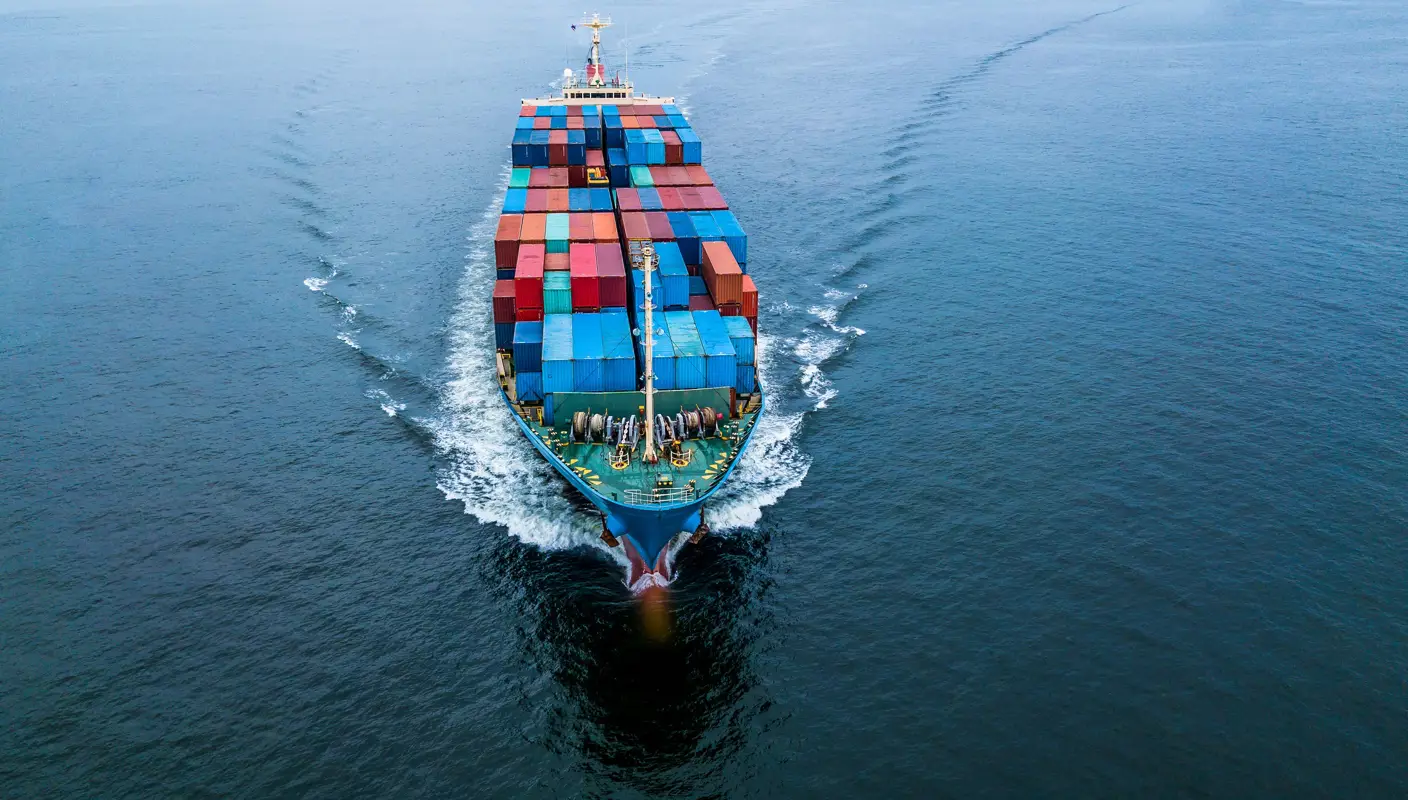
March 25, 2019
Technical and operational measures can improve performance, but it is vital that performance monitoring systems are used to measure their effect.
The purpose of this whitepaper is to provide a general overview of developments, challenges and advances that are used to further improve vessel performance. A particular focus is directed towards hull and propeller monitoring, enabled and assisted by an open ISO standard and data-driven solutions. These, combined with proven quality hull coatings, can ensure operational efficiency – and save money.
Shipping is recognized as an efficient mode of transport and has steadily improved safety and environmental performance over the past few decades. However, there are still significant challenges ahead, including the convergent problems of overcapacity, low margins and new digital demands from customers. At the same time, seaborne trade is expected to increase significantly over the next few decades and shipping will need to be even more efficient than today if it is to service the increase in cargo demand, and stringent regulatory efficiency requirements.
The industry is already taking steps to improve its environmental footprint, with the International Maritime Organisation (IMO) and state actors such as the EU and the US government having introduced or proposed measures to limit and reduce emissions to air and sea.
Such regulations as the Energy Efficiency Design Index (EEDI), the EU Monitoring, Reporting and Verification (MRV) regulation, the IMO Data Collection System (DCS), Volatile Organic Compounds (VOC) emission regulations and ballast water management regulations have come into force and colour decisions made by stakeholders in the industry, including owners, operators, charterers, financiers, yards, class societies and product and equipment suppliers.
Stricter limitations on sulphur emissions in 2020 are also likely to pose many challenges to ships operating as the entire globe is effectively designated as an Emission Control Area (ECA), with a sulphur cap of 0.5% in the fuel oil. And it seems only a matter of time before we see broader regulation of carbon emissions; last year, the IMO reached a landmark agreement on reducing greenhouse gas emissions by 50% by 2050 – compared to 2008. The IMO might also regulate biofouling in the coming years.
These regulations require an increasing level of environmental performance whilst owners and operators face mounting pressure to maintain the competitiveness of their vessels. Some of the technical and operational measures being used in the push for more efficient and sustainable operations are:
Industry interest in performance management systems to monitor the performance of a fleet, (including voyage, hull and propeller, engines and systems performance), is growing as operators work to achieve greater efficiencies. Poor hull and propeller performance alone is currently estimated to account for around 10% of the world’s fleet energy cost and corresponding greenhouse gas emissions.
Regular monitoring, then, on factors influencing ship performance, such as fuel consumption, speed loss and trim optimization, can help operators keep track of the vessel’s condition and how they are performing. Also, performance monitoring tools can enrich the operator’s own fleet reports with additional data from sources such as Automatic Identification System (AIS) and provide benchmarking capabilities.
The use of proven quality hull coatings is another area where the operators – and the industry - can achieve significant impact, with both environmentally and financially sustainable solutions. Indeed, the choice of a high performance antifouling system is important since fouling significantly reduces a ship’s speed whilst increasing fuel consumption and hence operating costs and exhaust emissions. Reductions in efficiency due to fouling could typically vary from around 5% - 20% so coatings are mentioned frequently in rules and guidelines as a major contributor to improved performance.
At the same time, most coating suppliers argue that their antifouling coating systems offer significant fuel and emission saving potential. However, monitoring is often challenging due to several rapidly changing factors that influence fuel consumption including draft, trim, ship speed, and wind. Also, while the different monitoring solutions all have a similar basic approach, the available approaches are difficult to measure – and, in turn, many performance claims are difficult to substantiate.
In view of the above, Jotun, together with over 50 industry stakeholders, devised a means by which the performance of coatings can be measured in a standardized way. Published in late 2016 the voluntary ISO 19030 standard can be used to quantify changes in hull and propeller performance before and after the application of a new coating, thus providing a means to calculate Return on Investment (RoI) for owners and operators. The standard prescribes measurement methodology and defining performance indicators for hull and performance maintenance, repair and retrofit activities. It sets out four key performance indicators:
The voluntary standard offers a two-tier methodological approach: ISO 19030-2, the default measurement method, with the most exacting requirements and greatest measurement accuracy; and ISO 19030-3, allowing for ‘alternative methods’ and included in order to increase the applicability of the standard.
In a recent case study, Jotun applied the ISO 19030 framework on an LNG carrier over the course of 8 years. The case study shows how the application of ISO 19030 can enable greater transparency in the hull coatings market, and assist decision-making for shipowners and operators, ultimately leading to a more fuel-efficient industry.
From 2020, the IMO 0.5% global sulphur cap will take effect. Experts disagree on what the outcome of the regulation will be on the maritime segment; but most agree that fuelling vessels will become a more complicated and expensive business. Maximising fuel efficiency, then, will once again be owners’ top priority, and with this in mind, the ability to measure and quantify performance improvements will be vital.
Published in late 2016, the voluntary ISO 19030 standard encompasses guidelines for doing just that. Dedicated to isolating ship hull performance from other factors such as waves, wind, propeller speed and engine efficiency, it can – and in Jotun’s opinion, should – be used to quantify changes in hull performance over consecutive drydocking intervals.
To achieve this, measurements must take the four performance indicators into account. All are important for those operators who are seriously working to achieve improvements, though some consider dry-docking performance as the key indicator. This determines the effectiveness of the works undertaken, by taking measurements following present out-docking, compared with the average from the previous out-docking – over a period of one year.
In the case study, Jotun applied the ISO 19030 framework on an LNG carrier over the course of 8 years. Measurements were taken every 15 seconds, averaged into daily averages and plotted onto the data points in Fig 1. Operational parameters such as waves, wind, trim, load, and ballast condition cause considerable scattering, but the results demonstrate a clear trend.
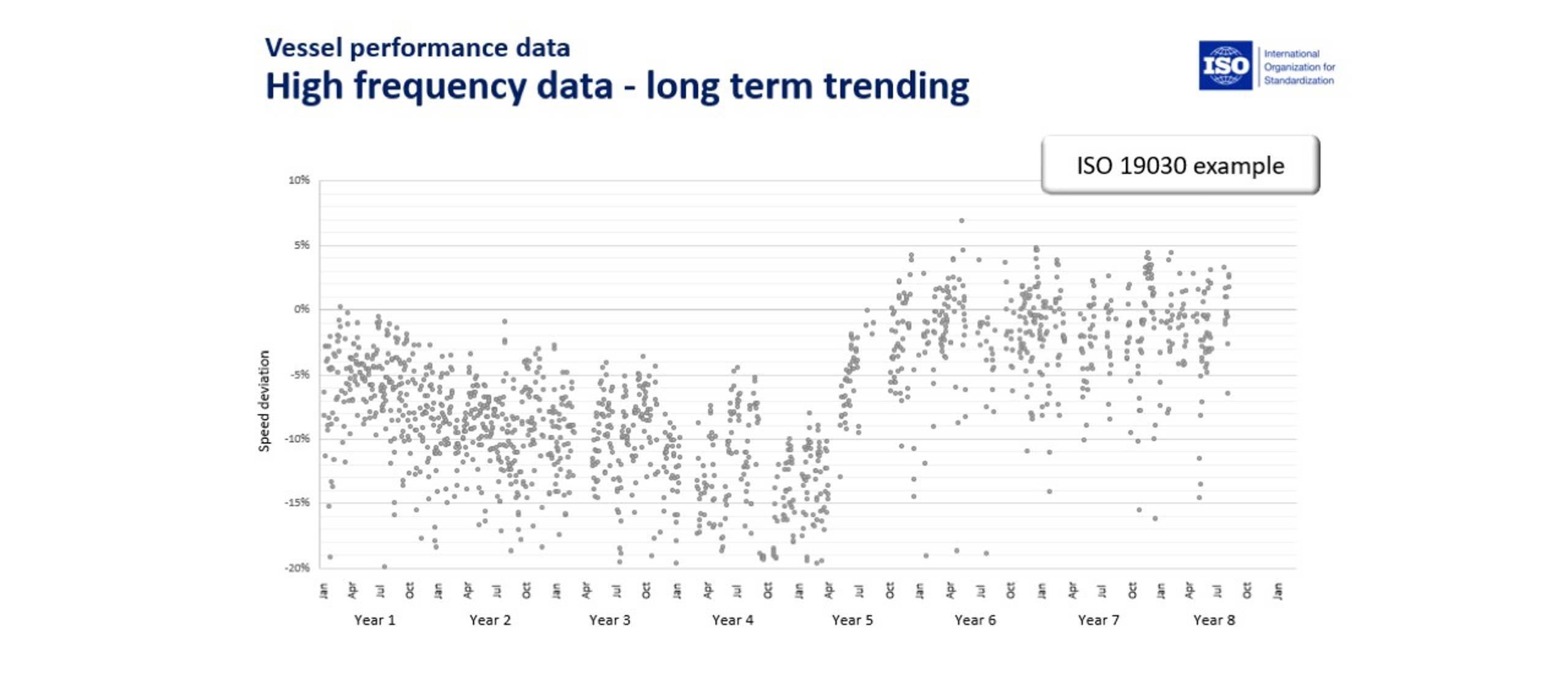
Fig 2 compares two 12-month reference periods; one immediately follows a spot blast application, and the other, after a full-blast. As the findings demonstrate, the full-blast application improved performance by more than 5%, showing that a poor-quality application can easily negate the benefits of even the most advanced premium coating.

Next, Jotun measured the hull’s in-service performance. Fig 3 plots the change in hull performance between the average during the year-long post-docking period (marked in red) and the rest of the in-service period between drydocking (marked in black). The difference between the averages of these two periods demonstrates a 4% decrease in performance following the spot-blast application; in one case, the reading falls as low as -10%. Meanwhile, comparing the same two periods after the full-blast application shows an almost negligible increase of a few decimal points.
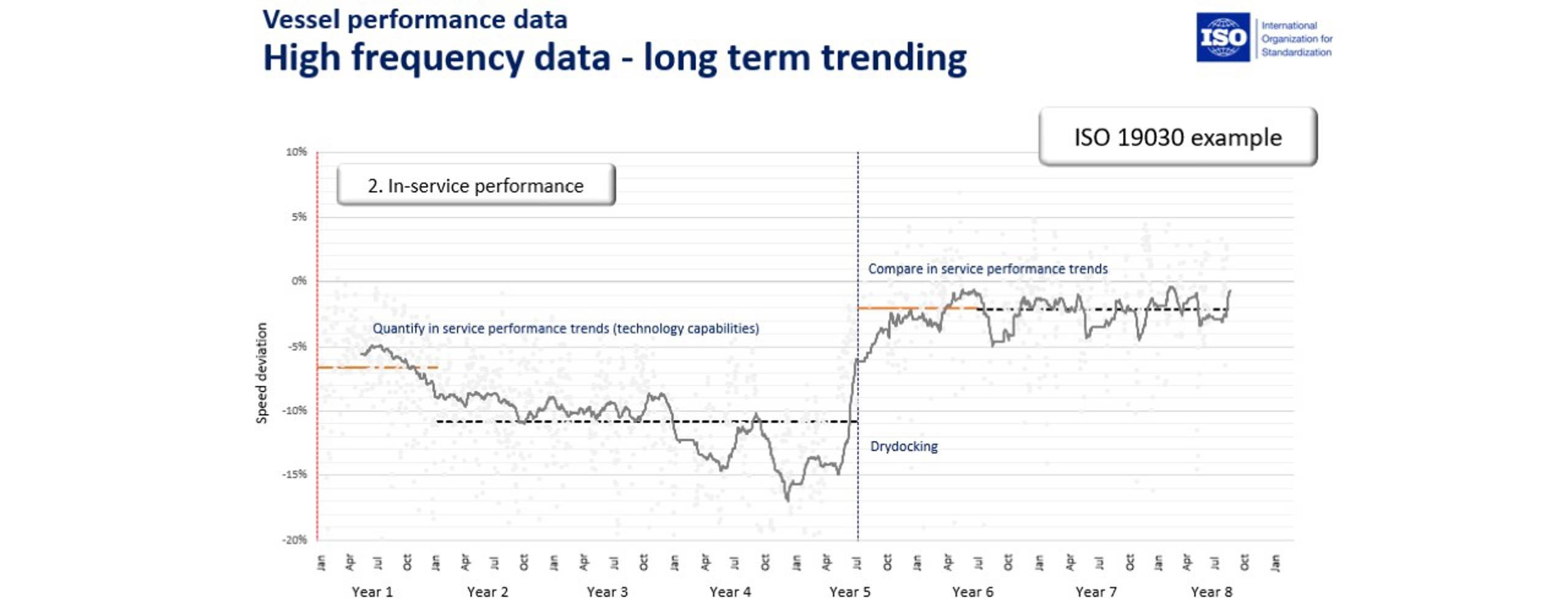
Figs 4 and 5 deal with maintenance trigger and maintenance effect, the last two performance indicators under ISO 19030. In Fig 4, we see a drastic drop in performance from November year 3 to April year 4, which triggered an underwater hull and propeller inspection. Once the hull of the LNG carrier was cleaned, performance improved substantially.
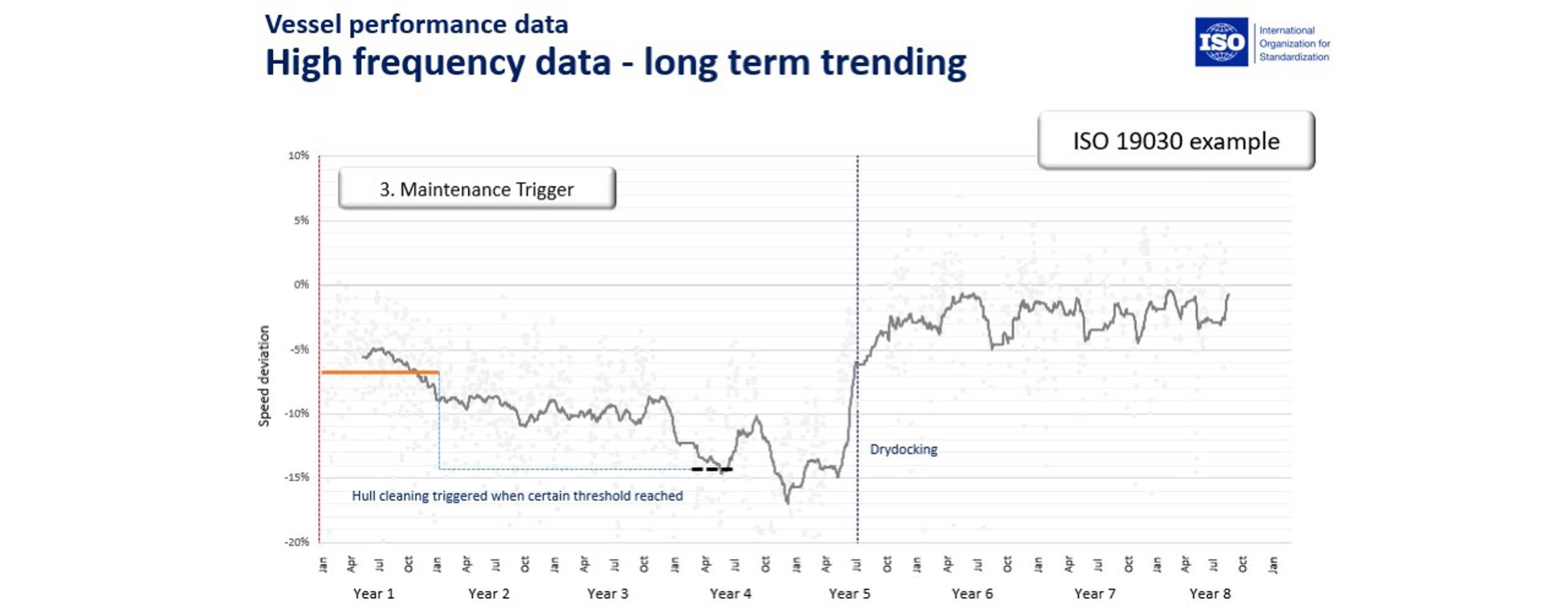
Fig 5 shows maintenance effect - the performance improvement between the three months preceding and the three months following the drydocking. Findings were dramatic; though the previous coating was heavily degraded by June year 5 as shown in the graph, the results show a 9% improvement in performance following drydock.
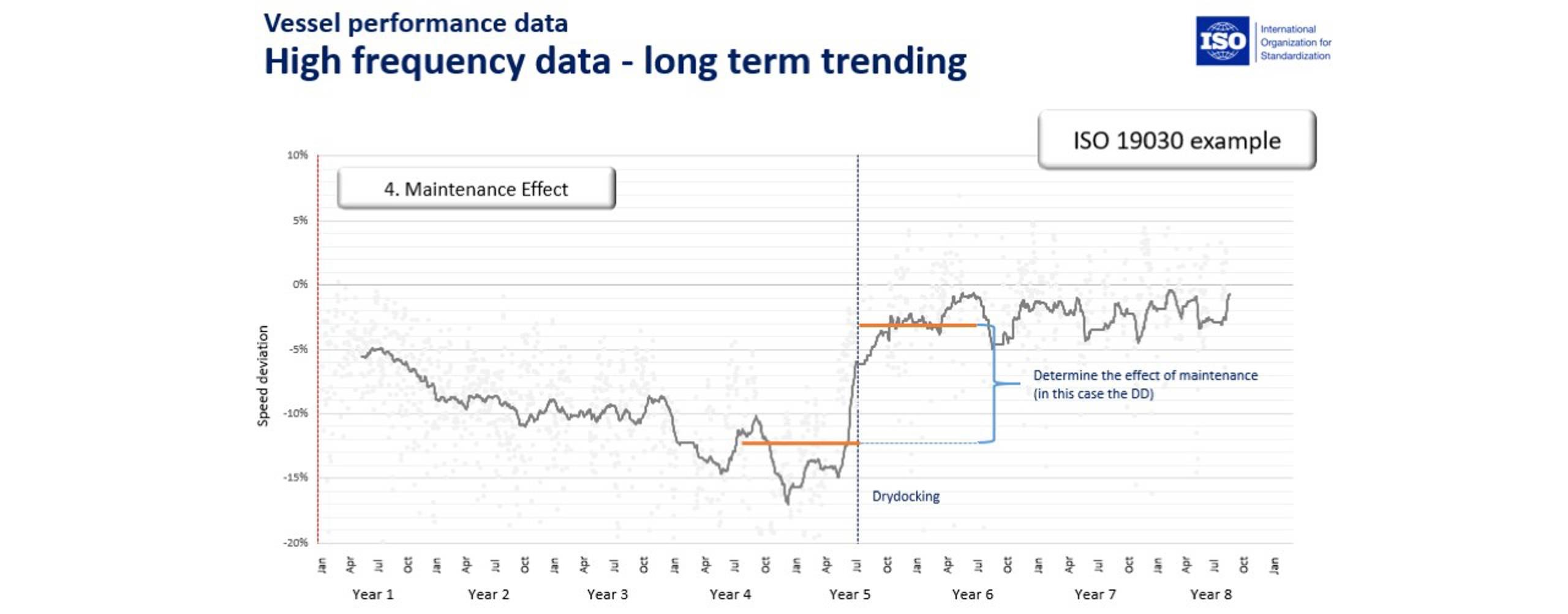
The standard itself does require the operator’s active participation in performance monitoring which can involve fitting sensors and making use of software products from third parties, or having a third party analyzing the data on their behalf. However, this helps operators to better measure hull and propeller performance by moving from the traditional way of monitoring (noon reporting) into the new era of big data, which can be used to ensure high performance.
The cost of outfitting ships with performance measurement systems can be done in an inexpensive way. The basic approach in ISO 19030-3 is to use noon reports. This way, operators will at least have indications on overall performance. By investing in some additional equipment, the accuracy can be significantly improved. In order to comply with ISO 19030-2, which is based on high frequency data, a datalogger, torque meter and some cabling is required. Alternatively, flowmeters can be used. Both torque meters and dataloggers are becoming very affordable these days, allowing for a quick return on investment.
As a starting point, operators are recommended to start using the standard to improve the quality of the vessel noon reports in order to become familiar with the methodology. As a next step, they can then look into investing in the required equipment should they want to comply with ISO 19030-2 to get more accurate performance data.
Regardless of whether or not the ISO 19030 standard is being applied, getting the cost-effective performance relies upon several other factors. For starters, the choice of high performance antifouling coating system is important as it should, ideally, suit the vessel’s normal operating profile. Currently there are a number of technologies, in various stages of application and development, for dealing with different fouling challenges and trades.
Surface preparation and the use of anticorrosive primers are also key since a poor surface preparation can completely negate the advantages of a premium hull coating. Also, frequent propeller cleaning is probably the lowest cost approach to reducing fuel consumption and improving performance.
For vessels exposed to high mechanical wear, such as cargo loading/off-loading and frequent canal passages the mechanical properties of the primer should be considered to avoid significant roughness development due to the mechanical impact.
Operators should also conduct regular underwater hull inspection and cleaning when required. New ideas and technologies are constantly emerging in this field, including hull cleaning robots. An underwater hull cleaning carried out at an earlier stage minimises performance losses due to fouling organisms and minimizes the risk of damages to the coating.
Ensuring that the correct new building paint specification is discussed with the paint supplier’s experts from the start is also recommended. Often antifouling systems are specified as ‘TBT-free self-polishing coatings for 60 months’ leaving leeway for yards to ask for a low-cost system, and for paint makers to try to cut costs by offering their lower range, just-about-suitable products. Operators that are more specific and willing to invest a bit more at the initial stage, will recoup much greater savings over the first drydocking interval of the vessel. Evaluating operational patterns is another means to reduce costs and ensure the correct specification.
At Jotun, we firmly believe that fully exploring the potential of efficiency gains through performance management is key to sustainable operations and will be a principal requirement for ships of the future. The industry in general is becoming more complex and challenging with stakeholders like charterers, banks and regulators, all pushing for more efficiency and transparency. Adopting sustainable business practices and monitoring in accordance with recognised standards will help operators meet the increasing performance demands and regulatory requirements.
Making the EU-MRV readings public may also impact a vessels attractiveness to pools and charterers with several possible vessels to be included in their fleet. A vessels attractiveness on the second hand market may also be affected by such databases.
In relation to coatings and hull and propeller performance in particular, Jotun recommends operators to start measuring performance according to ISO 19030. It is a good starting point to offering a level playing field and the adoption of industry-wide best practices and transparency. Operators can also reduce their fuel costs and emissions significantly if they opt to use proven quality coatings and a standardized approach and data-driven solutions.
Indeed, at a time when market pressures and regulatory developments are forcing the maritime industry to focus on energy efficiency and meeting environmental challenges, owners and operators are eyeing opportunities in efficiency-based solutions and technologies.
As an example, Chevron Shipping has set up a collaborative project to optimise the hull and propeller performance on its ships. The ongoing project involves using noon report data for a sub-set of the Chevron fleet according to Johnny Eliasson at Chevron Shipping. “The ISO 19030 standard is helping to create awareness of advancing hull and propeller management. It might not be perfect yet but it’s vital that it is being used, implemented and tested.
Constructive feedback can then be given as part of the revision process (in 2019) to help upgrade the standard further,” says Eliasson.
Using new methods and data analytics to improve performance monitoring is also backed by Francesco Bellusci at Scorpio Ship Management and member of Intertanko. Explaining why tanker operators are interested in performance monitoring, Bellusci comments, “Historically there’s the focus on speed and fuel consumption for commercial reasons. Also, it’s a way of ‘surviving’ fuel cost spikes. New regulatory pressures relating to GHG emission reductions and the industry trend towards big data approaches for new vessel designs, and energy efficient solutions (including hull coatings) are also drivers,” he says.
Intertanko recently set up a working group to address performance monitoring issues and future challenges. The group is currently investigating the potential of establishing a model for advancing performance monitoring practices. As part of the terms of reference, the group is looking into the possibility of expanding the concept of ISO 19030 to cover ship efficiency measures beyond hull and propeller performance.
Market research by Jotun reveals only about 15% of the world’s fleet is equipped with high frequency performance monitoring equipment and only around 8% are using the data efficiently. There are major opportunities for owners, managers and charterers to use past data to optimise decision-making on future hull and propeller maintenance strategies.
Jotun Hull Performance Solutions (HPS) uses comprehensive ship data from several performance monitoring companies to provide Jotun’s own analysts with the data needed to identify short-term patterns as well as long-term trends. This enables Jotun to suggest several future maintenance strategies based on budget and a ship’s operating profile.
Jotun’s HPS service is aligned with ISO 19030 and covers SeaQuantum antifouling coating systems, technical service, performance monitoring and performance contracts. It is now in operation on board close to 900 ships worldwide.
Do you want to learn about how Jotun can help your company optimise vessel performance through proven quality coatings and reliable analysis? Contact us!
Erik Risberg
Global Marketing Director,
Jotun Marine Coatings
Erik.Risberg@jotun.no
Stein Kjølberg,
Global Concept Director
Jotun Hull Performance Solutions
Stein.Kjolberg@jotun.com

Biofouling – the next big environmental battle? What will it mean for coating makers and operations in general? ShipInsight put these fundamental questions in the spotlight.

Many companies talk of ‘digital disruption’ or ‘paradigm shift’; but very few can explain exactly where to start the digital journey with any kind of certainty argues digital expert.

Sustainability is gaining a foothold in the maritime industry. Jotun Maritime Insider looks at why it matters and what measures companies are taking to achieve safer, greener and more efficient operations.
A video is being shown
An image is being displayed
A brochure is being displayed